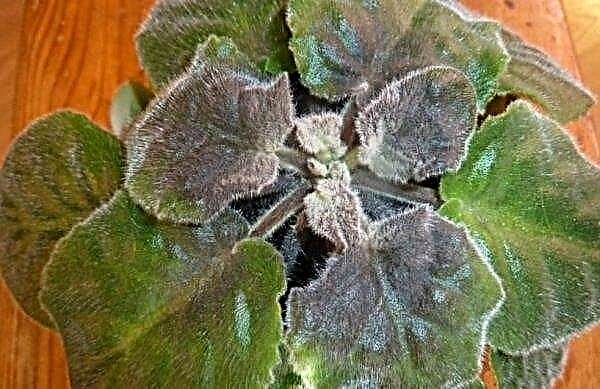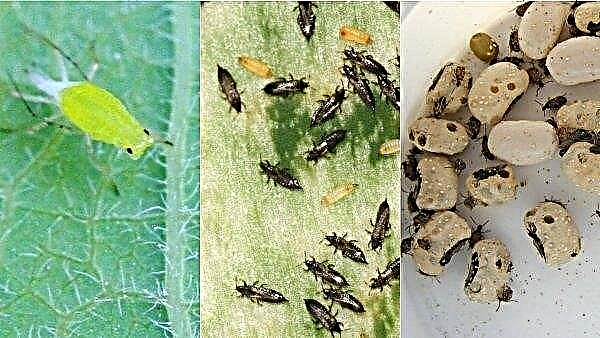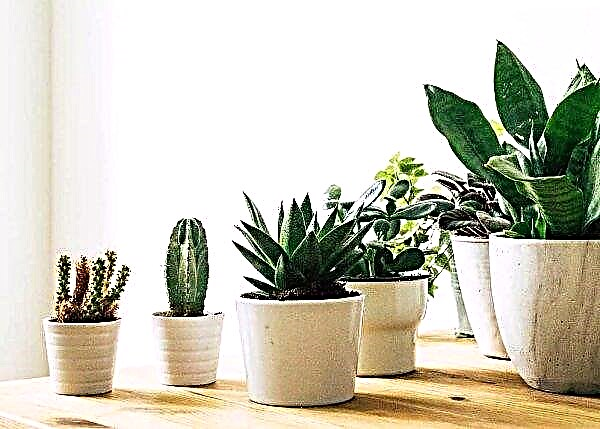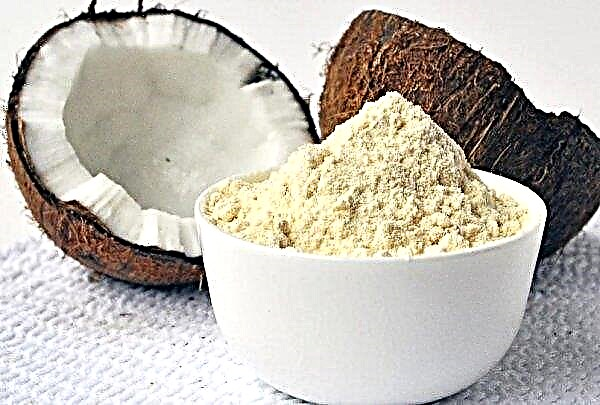Spathiphyllum is not a particularly demanding flower, so the owner does not cause unnecessary trouble. Nevertheless, there are a number of problems associated with the care and diseases of plants, the solution of which is quite a problem. The most common is yellowing of the foliage. What becomes the reason for changing the color of the leaves, and how to prevent this, we will tell further.
Botanical description of the plant
Spathiphyllum is popularly called "female happiness." The flower came to us from the countries of South and Central America. Its oval foliage with pronounced veins grows from a basal rosette. Leaf petioles expand to the base. During flowering, it blossoms a flower in the form of a cob, covered on one side with a snow-white sheet-veil.
Why do the leaves of spathiphyllum wither, and what should I do?
Most often, the reasons for the color change of the foliage of spathiphyllum lie in non-compliance with the rules for caring for it.
Did you know? It is widely believed that spathiphyllum scares away uninvited guests, because of this it is also called the "home spirit".
Overdried land
Rare or not plentiful watering leads to the fact that the land becomes overdried. It is difficult for a flower to receive the elements necessary for it, and there is also an acute lack of moisture. Because of this, the leaves first lose their elasticity, then turn yellow. The earth is covered with dry crust. It is dangerous to water such a flower sharply.
First you need to pour half of the usual amount of moisture. After the procedure, you need to cover the flower with a transparent bag. The next irrigation procedure is carried out after a day or two using the same amount of water.
Heterogeneous soil
The heterogeneity or poor quality of the land leads to a shortage of nutrients. This leads to drying out of the leaves. It is necessary to transplant the plant, filling the pot with a light nutrient mixture with a drainage layer.
Root decay
Blackening of the tip of the leaf plate of spathiphyllum indicates root jamming and the beginning of putrefactive processes. In this case, the flower needs to be urgently saved, otherwise it will die. Salvation will be a transplant into a new pot with fresh soil. Before planting, the root system must be inspected, the affected roots removed, and the rest treated with activated carbon.
Did you know? It is useful to keep spathiphyllum in houses where repairs are underway, as the flower absorbs vapors of benzene, acetone, ammonia and other chemicals.
Wrong watering
Even if spathiphyllum is watered, the foliage may still turn yellow. The reason may be that irrigation is not systematic (rare or very frequent), cold and hard water is used. It is also detrimental to the plant if excess water after irrigation remains in the pan. If the leaves turned yellow, but not blackened, and the soil is moist, then most likely watering was frequent, so you need to get rid of excess moisture. To do this, lay out paper napkins on the surface of the soil, on the leaves, under the bottom of the pot. When they are saturated with moisture, they clean and spread new ones. Repeat the procedure until the wipes remain dry.
To do this, lay out paper napkins on the surface of the soil, on the leaves, under the bottom of the pot. When they are saturated with moisture, they clean and spread new ones. Repeat the procedure until the wipes remain dry.
Hypothermia
With a long stay of spathiphyllum in a draft, in a cold room, or if water remained in the pan and the window sill is cold, then the leaves from the tips begin to blacken. Moreover, blackness often appears on very young leaves that did not have time to open. Old leaves may wilt. Such a flower must be removed from the soil and examined the roots. If they are alive, treat with “Elin” and plant in new soil.
Important! If, due to the cold, the root system of the flower has died, it is thrown away, since it cannot be restored.
Incorrect plant transplant
Poor or inappropriate land, a pot of the wrong size, can cause the “female happiness” to turn yellow after the transplant. The soil must be used air- and water-permeable, and under it pour a layer of drainage. The flowerpot is chosen commensurate with the size of the flower. If after transplanting you are not sure whether the soil is suitable, water it and see how it absorbs moisture. If it’s bad, change the soil to more loose, lighter, with minerals. After changing the pot, do not water the flower strongly. Better process it with Zircon. It will help you quickly adapt to a new place. If there is no drug at hand, you can cover the pot with “female happiness” with a transparent bag and leave it in this form for a couple of days.
If it’s bad, change the soil to more loose, lighter, with minerals. After changing the pot, do not water the flower strongly. Better process it with Zircon. It will help you quickly adapt to a new place. If there is no drug at hand, you can cover the pot with “female happiness” with a transparent bag and leave it in this form for a couple of days.
Diseases and pests from which spathiphyllum withers
Often the causes of discoloration of the foliage and deformation of the leaf plate are diseases and pests. If you looked closely at the spathiphyllum and found that tiny insects live on the back of the leaf and on the stems, and the flower itself began to wilt, it was most likely attacked by aphids. In this case, the plant must be treated with a feverfew. The procedure is repeated every 14 days until the pest disappears.
It may be such that when examining the flower, small red insects and a thin cobweb covering everything around were noticed. This is a spider mite. It can be expelled by insecticides, the processing of which is carried out once every 14 days until the complete disappearance of the insect.
It is also possible that the foliage dropped, the soil and the basal part of the stems were covered with mold. This is how gray rot manifests itself due to waterlogging. It is necessary to dry the soil with napkins, clean the drainage holes in the pot. If the plant does not come to life, you should examine its roots, perhaps the disease struck them as well. In the presence of diseased roots, a spathiphyllum transplant is performed.
How to save a plant by transplant?
From the foregoing, it can be concluded that transplantation is the salvation of the plant from many problems. But this procedure must be carried out correctly, otherwise there will be no positive changes.
For this:
- Carefully remove the flower from the flowerpot, shake the ground.
- Wash away any remaining soil in a container of water.
- Inspect the root system. Leave light healthy roots, and cut off the rest.
- Sprinkle slices with powdered activated carbon.
- Put the flower on paper so that its roots can dry (2-3 hours).
- Fill a new pot with fresh earth. Stir in a tablet of activated carbon to prevent rotting of the slices. The soil should consist of sheet land, peat, coarse sand, charcoal and humus.
- Pour drainage. The pot must have drainage holes.
- Moisten the soil and plant a flower in it, moistening the soil a little more after planting.
Important! The first watering after transplantation is carried out after two to three days. Use settled room temperature boiled water mixed with «Kornevina».
Features of further care
After transplantation, it is not difficult to take care of spathiphyllum, but you need to be careful and follow the rules:
- Keep the earth moist, not wet.
- Every two to three days in the winter and daily in the summer with irrigation procedures, spray the foliage.
- Do not allow direct sunlight to fall on the spathiphyllum. Check that the temperature in spring and summer is not higher than + 26 ° C. In winter, it should not fall below + 16 ° C.
 Yellowing and wilting of the leaf plate, first of all, is the result of poor care of the plant. Correcting the situation is not easy, therefore it is better to always carefully monitor the condition of the flower, how the soil absorbs moisture. As soon as the first signs of discoloration of the sheet plate are noticed, urgent need to take action.
Yellowing and wilting of the leaf plate, first of all, is the result of poor care of the plant. Correcting the situation is not easy, therefore it is better to always carefully monitor the condition of the flower, how the soil absorbs moisture. As soon as the first signs of discoloration of the sheet plate are noticed, urgent need to take action.












